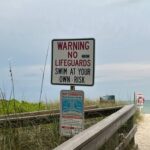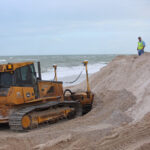VERO BEACH – The Vero Beach Historic Preservation Commission is the latest agency to promise protection of the archaeologically significant Vero Man site. The commission approved asking the Vero Beach City Council to pass a resolution aimed at protection, preservation and future excavation of the site.
“I don’t believe there’s another site” with such significance,” world-renowned anthropologist Dr. Barbara Purdy told the commission Wednesday morning. Dr. Purdy traveled from Gainesville Tuesday to walk the site and evaluate other areas that could yield archaeological finds.
“I’m convinced” there are some still undisturbed sites, she said.
The site is located in the vicinity of Piper Aircraft and the County Administration complex in the north end of the city and was discovered in the early 1900s when Indian River Farms began cutting canals in the area.
The site is significant because it is one of only two documented sites in the Western Hemisphere where human remains have been found along side those of “megafauna” now extinct.
Such animals found include a mastodon, predecessors of tapirs, sloths and horses, a mammoth and a saber-toothed cat.
The City of Vero Beach has promised to install fencing around the site. But that has not yet happened. Instead, No Trespassing signs have been set up around the area warning people off the property.
Dr. Purdy and historians would like to see the site formally excavated to find out what else might be hiding under the ground’s surface.
“We don’t know what’s down there but I suspect it’s the mother lode,” Commission member Chris Crawford said.
Before excavation can commence, however, steps have to be taken to protect the site, get it designated as an archaeological zone and have it listed with the National Register of Historic Places – all of which would help in raising funds through grants and foundations, according to County Historian Ruth Stanbridge.
She asked the Vero Beach Historic Preservation Commission to craft a resolution to go before the city council recognizing the importance of the site by working with county leaders to protect it. The site is on both city and county owned land.
“I don’t think we need to waste another minute” justifying the resolution, said Commission Chairwoman Debra Atwell, who likened the site’s importance with that of finding the “missing link. It’s that important.”
Though the commission favored the resolution and supports excavating the site, commission members did raise issues of funding, leadership and ownership.
City Planning Director Tim McGarry told the commission that because the site is primarily on the city’s land, the city could expect to take leadership of the excavation endeavor as well as ownership of any artifacts unearthed.
Funding, however, could be organized through a few groups, including the Indian River County Historical Society and possibly a sub-committee of the Cultural Council, the Old Vero Ice Age Sites Committee. Details on how fund-raising efforts would be handled have not yet been determined.
After the county and the city pass their own resolutions of support and protection – expected in February – Stanbridge said she would take those to the Florida Historic Preservation Office to have the site listed on the Old Master Site file and recognized on the state level. From there, Stanbridge said she would work to get the site listed with the National Register of Historic Places.
In the meantime, McGarry said he would review the city’s codes pertaining to historic preservation and craft the necessary language to address archaeological sites. He plans to report back at the commission’s next meeting.






